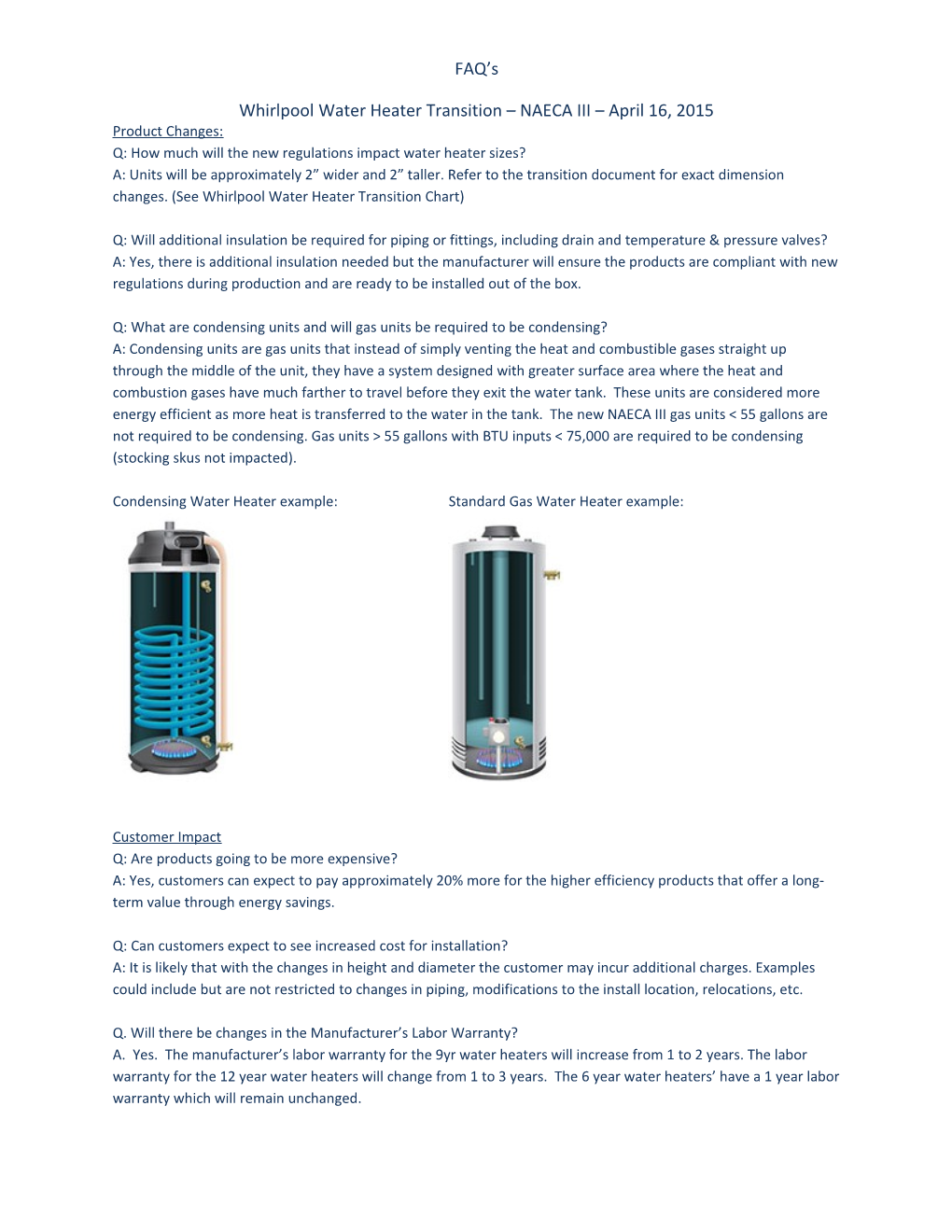FAQ’s
Whirlpool Water Heater Transition – NAECA III – April 16, 2015
Product Changes:
Q: How much will the new regulations impact water heater sizes?
A: Units will be approximately 2” wider and 2” taller. Refer to the transition document for exact dimension changes. (See Whirlpool Water Heater Transition Chart)
Q: Will additional insulation be required for piping or fittings, including drain and temperature & pressure valves?
A: Yes, there is additional insulation needed but the manufacturer will ensure the products are compliant with new regulations during production and are ready to be installed out of the box.
Q: What are condensing units and will gas units be required to be condensing?
A: Condensing units are gas units that instead of simply venting the heat and combustible gases straight up through the middle of the unit, they have a system designed with greater surface area where the heat and combustion gases have much farther to travel before they exit the water tank. These units are considered more energy efficient as more heat is transferred to the water in the tank. The new NAECA III gas units < 55 gallons are not required to be condensing. Gas units > 55 gallons with BTU inputs < 75,000 are required to be condensing (stocking skus not impacted).
Condensing Water Heater example: Standard Gas Water Heater example:
Customer Impact
Q: Are products going to be more expensive?
A: Yes, customers can expect to pay approximately 20% more for the higher efficiency products that offer a long-term value through energy savings.
Q: Can customers expect to see increased cost for installation?
A: It is likely that with the changes in height and diameter the customer may incur additional charges. Examples could includebut are not restricted to changes in piping, modifications to the install location, relocations, etc.
Q. Will there be changes in the Manufacturer’s Labor Warranty?
A. Yes. The manufacturer’s labor warranty for the 9yr water heaters will increase from 1 to 2 years. The labor warranty for the 12 year water heaters will change from 1 to 3 years. The 6 year water heaters’ have a 1 year labor warranty which will remain unchanged.
Q. Will the Manufacturer’s Parts Warranty change with the new water heaters?
A. No.
Process Impacts:
Q: Are permit and/or change order charges expected to increase as a result of the NAECA III regulations?
A: Both permit fees and change orders may increase in dollar amount and frequency as a result of the changes in unit size. The impact could be minimal to more substantial depending on the situation and municipality.
Q: Will clearance regulations be changing as part of this change?
A: Clearance guidelines will remain the same as they are today, however the increased size of the units could mean the customer will need a smaller unit or additional labor to stay compliant with local codes.
Q: Will new venting be required for installation?
A: Product ventilation will not change, however height changes could impact the venting lines.
Q: With the change in product dimensions, can new vents be installed if needed?
A: Yes, excluding masonry work to a brick, stucco or stone exterior. The installer must also ensure the old vent is capped. (See new scope of work).
Q: Can installers relocate or add new electrical?
A: Yes, with proper licensing the installer can add a new outlet or move electrical supply if:
- The move doesn’t require more than 20 feet of electrical wiring to be run from the current electrical source
- Does not require additional circuit breaker to be added
- Doesn’t require a new panel box to be installed
- Gas units can only be relocated within 4 feet of existing as gas lines can only be extended and not moved.
Q:Will the size changes mean units will now be too large to fit throughan attic opening?
A: Diameters have increased for some units; however no unit willbe larger than 24” in diameter.Please consider the size changes when selling product as customers may need to choose a smaller gallon size to allow the new product to fit through the attic opening. If attic stair removal/replacement is needed, there will be an item number added to ISST to allow for this work. The production office may need to coordinate the project with Lowe’s current attic stair installer.
Q: What options are available for customers as a result of the regulation changes?
A: Options to consider if space is a concern:
- Choosing a unit with a smaller gallon size
- As 80 gallon units go away, it may be necessary for customer’s to purchase 2 40-gallon units
- Products with an insulation blanket can be purchased via Special Order. This is a good solution for customer’s installing in attics as it allows the product to fit through the opening then the blanket is added making the unit NAECA III compliant.
- Tankless water heaters are another option. Lowe’s is partnered with Rinnai as a Type II installation program.
- Product solutions that include a tank water heater with a tankless unit attached will be availablevia Special Order. This solution will mitigate space issues while providing the gallon size needed.
- Plumbers will now have a Custom Work-Attic Stair Removal/Replacement item number which will be created. This allows installers to be able to remove/replace attic stairs as needed to complete installation. Until new item number is created, installers can put this under the current Custom Work item number.
*Reminders:
- Ensure installers are comfortable with the upcoming federal changes and the subsequent adjustments to the SOW to account for these changes.
- Ensure installers have change order documents on their trucks with them
- If a customer pays the installer for the change order with a check, it must be back to the store within 24 hrs
- Installers will need to work closely with the stores to ensure the water heater database is kept up to date
